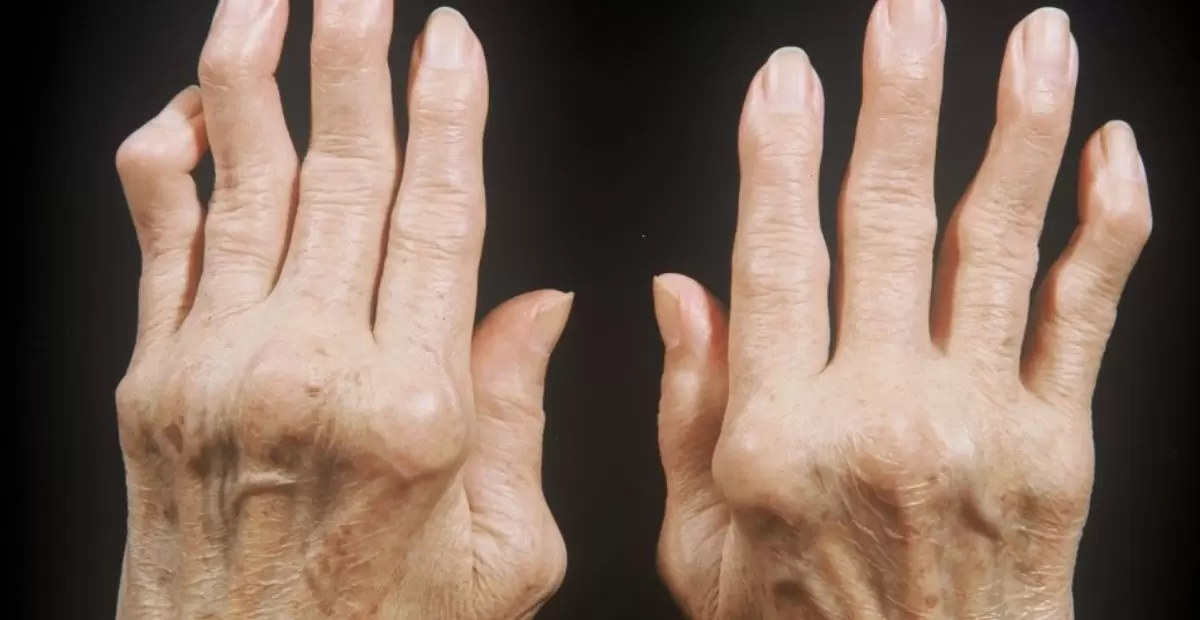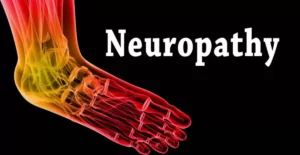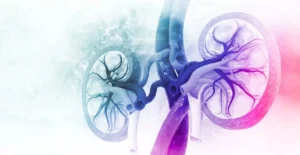Rheumatoid arthritis is a chronic disorder that can cause inflammation in the affected joints and other body parts. This disease attacks your immune system and deforms your joints. It may damage your stomach, skin, eyes, lungs, heart, and blood vessels by attacking your immune system. Sooner treatment for curing rheumatoid arthritis is very essential.
Rheumatoid arthritis, a comprehensive guide, helps us understand a tricky condition. It helps when your joints are deformed or inflamed. This book explains why this happens and what we have done in this condition. It’s like having a map to navigate through a painful journey. With this guide, we can learn how to take care of ourselves better.
The painful swelling related to rheumatoid arthritis also damages other body parts by affecting nearby cells. It can lead to the deformation of joints like hands, fingers, feet, wrists, knees, ankles, and toes. This shows many symptoms like stiffness, fatigue, inflammation, weakness, and fever. Rheumatoid arthritis affects people of different ages between 30 and 60 years of age.
How do Normal and healthy joints work?
A place where two joints meet is called a joint. Our joints are designed to allow the bones to move in specific directions within limits. For example, the Knee joint is a strong joint that helps to stand upright and acts as a hinge joint. A hinge joint moves bones in every direction and helps in walking, bending, and running during sports.
Cartilage covers the end of each bone and protects the bones just like a cushion. It allows the bones to move against each other without rubbing. Synovium, a thick fluid holds the joints in place and protects them. It has a rigid outer surface which protects the bones from moving so far.
Bones join with muscles by a strong chord called a tendon. It helps in movement during work.
Causes of Rheumatoid Arthritis
Many factors combine and become the cause of the rheumatoid arthritis. The following can play a central role in why somebody suffers from rheumatoid arthritis.
Age
Rheumatoid arthritis affects adults of different ages but most people diagnose at the age of 40 to 60. It is diagnosed mostly in working people.
Sex
Rheumatoid arthritis is more common among women two to three times more than men.
Genetics
Rheumatoid arthritis can be a genetic disorder or caused by other environmental factors like diet and smoking. It may be a combination of genetic and environmental factors. Genetically, it increases the chance of developing this condition if your relative has suffered from it.
A diet with Vitamin-C Deficiency
Vitamin C is an essential element for the strength of the bones. If you consume a Vitamine-C deficient diet, you may have an increased risk of suffering from rheumatoid arthritis. Smoking is also a factor that increases the risk of rheumatoid arthritis.
Weight
Overwieghting can increase the risk of rheumatoid arthritis than a healthy and normal-weight person. BMI is a tool that can be used to calculate your weight by using height and weight.
An Ideal BMI is 18.5 to 24.9 range in adults.
Symptoms of Rheumatoid Arthritis
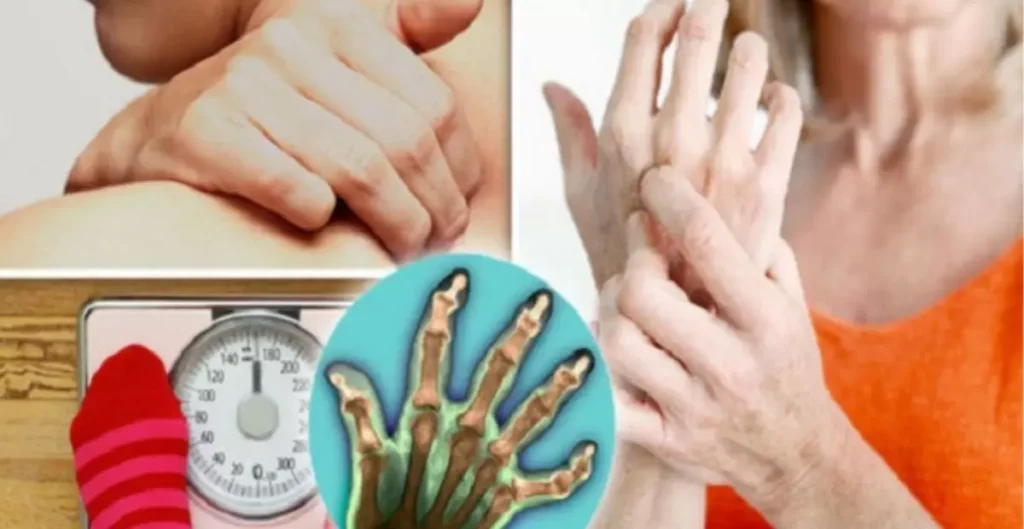
There are many symptoms of rheumatoid arthritis. But some main symptoms are:
- Stiffness of the joints
- Pain in joints
- Inflammation or swelling, and redness
- Bones deformation
Several other symptoms also include:
- Fatigue and weakness
- Fever
- Poor appetite
- High sweating
- Chest pain and dry eyes as a result of painful inflammation
Rheumatoid arthritis can affect almost all joints of the body but small joints such as hands and feet joints felt great effect. In several persons, it can develop fleshy nodules called rheumatoid nodules under the skin that are very painful. Both sides of the body are affected at the same time by rheumatoid arthritis.
Diagnosis
Rheumatoid arthritis is diagnosed based on your symptoms. X-rays, physical examinations, CT scans, and blood tests are used to diagnose rheumatoid arthritis. There is no test to prove that you have this disease or not. It is very difficult to diagnose because there are a few conditions that show the same symptoms.
1- Blood Test
There is no test to confirm rheumatoid arthritis but a few tests have shown the confirmed signs. These main tests are:
- Erythrocyte sedimentation rate (ESR)
- C-reactive protein (CRP)
- Full blood count
- Rheumatoid factor and anti-CCP antibodies
2- Scan
- X-rays
- Ultrasound Scan
- MRI (Magnetic resonance Imaging)
3- Physical Exercises
Your doctor will suggest you a physical examination test based on your symptoms. They will check your swollen joints and examine how your joints work or show movements. This chronic disorder affects other parts of your body. Your doctor might refer you to a rheumatologist or arrange one of the above blood tests to confirm this disease.
Treatment
There are several treatments available for rheumatoid arthritis. Any intensive treatment will be started after examining your symptoms. There are three main treatments used for rheumatoid arthritis.
- Drugs
- Physical Therapies
- Surgery
Drugs
Rheumatoid arthritis is a painful disease. So four main groups are used for the treatment of rheumatoid arthritis.
- Painkillers
- NSAIDs (non-steroidal anti-inflammatory drugs)
- DMARDs (disease-modifying anti-rheumatic drugs)
- Steroids
- Non-steroidal anti-inflammatory drugs (NSAIDs)
Drug treatment can be changed according to the condition of the disease. Drugs may be available in different names as in their generic name. Always medicins should be used according to the doctor’s prescription and may vary from condition to condition.
Physical Therapy or Physiotherapies
In a home health agency, small exercises are very essential rather than keeping long sitting. Physiotherapists can suggest suitable exercises to treat rheumatoid arthritis and help to keep active. They help to manage their conditions and suggest exercises accordingly.
- Hydrotherapy
- Ice Treatment
- Daily movement
- Hot and Cold Treatments
- Stress Reduction and Complementary Therapies
- Balancing activity with rest
These all ways are used as suggested by Physical Therapists. Hydrotherapy is used for easiness of symptoms recommended by your trained physiotherapist. It is a warm water exercise used for relaxing the joints and is also called aquatic physiotherapy.
Ice treatment, hot and cold treatment, and daily movements are used to lower inflammation or reduction of joint pain. Regular movements are an essential part of the physiotherapy. It helps to balance the activity and manage sitting time for the control or cure of rheumatoid arthritis.
Best Diet Plan for Rheumatoid Arthritis Patients
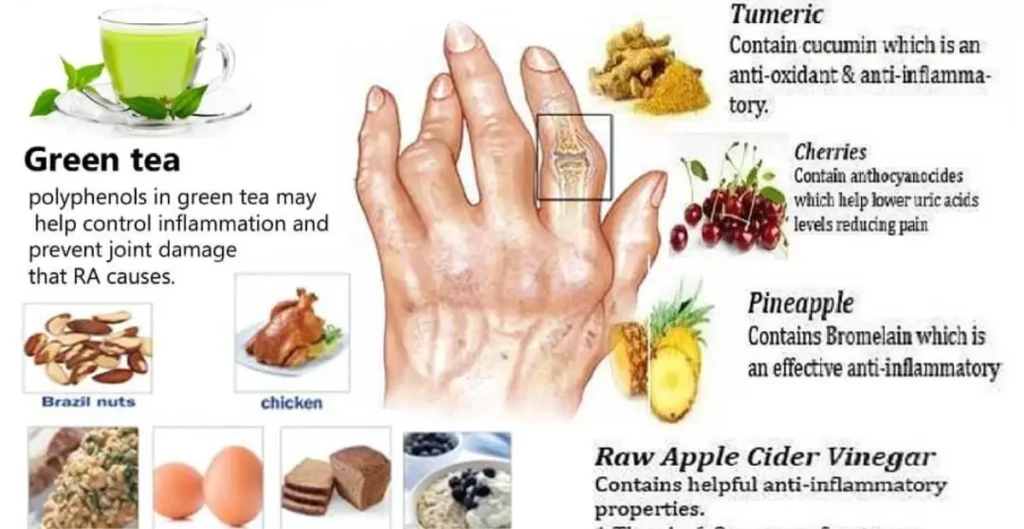
A Diet can not help in the treatment of rheumatoid arthritis but it can help in pain reduction or controlling inflammation. It can help to maintain your health and maintain your body weight. The use of green vegetables and fruits regularly protects you from over-weighting. Over-weightage or obesity produces a protein called cytokines that can promote painful inflammation.
A healthy diet plan is crucial for the maintenance of your health. It is not a treatment but a small trick used to avoid developing RA disease as prevention. There is a short diet plan that can be used for good health.
- Fatty Fish
- Fruits and veggies
- Peas and beans
- Whole grains
- Nuts
- Olive oil
FAQs
What are the worst foods for rheumatoid arthritis?
Many foods are worst for rheumatoid arthritis like tomatoes, milk, bananas, and very cold things such as ice cream, etc.
What are the 4 stages of rheumatoid arthritis?
The four stages of rheumatoid arthritis are Early-stage of RA, medium-stage of RA, Severe RA, and end-stage of RA. Their symptoms are based on different conditions of a person over time.
How to cure rheumatoid arthritis permanently?
There is no treatment for rheumatoid arthritis but the regular use of steroids and special care and exercises are better and highly recommended by physicians.
Conclusion
We know a lot about rheumatoid joint pain. It happens because our body’s protection framework gets confounded and goes after our joints. This makes them hurt and puff up. We can tell if we have it by looking for swollen, achy joints and feeling tired all the time. Doctors can also do special tests to be sure. When we realize we have it, there are things we can improve. Specialists can give us medication and activities to make our joints more grounded. They might even suggest changes to what we eat to help us feel less achy.
So, rheumatoid joint pain can be extreme, however, presently we know what to do. We discovered that it happens when our body battles against itself, causing torment and sluggishness. We can see whether we have it through our side effects and unique tests. Then, with the assistance of specialists, we can oversee it by taking medication, doing activities, and eating food sources that encourage us.

